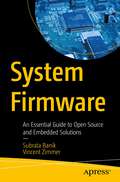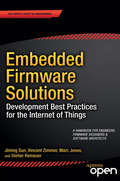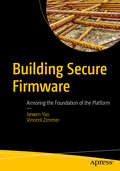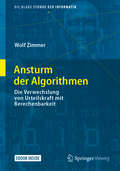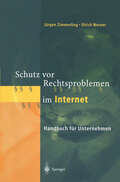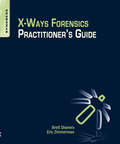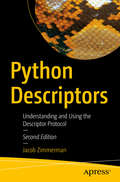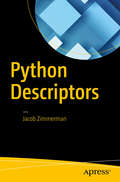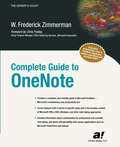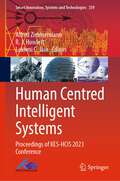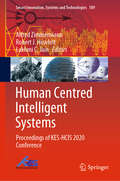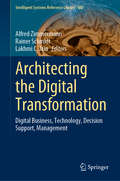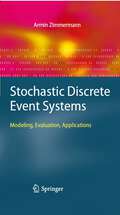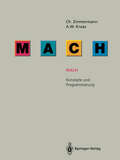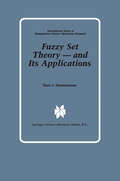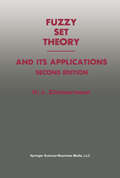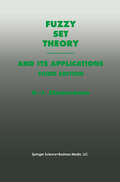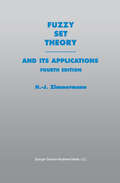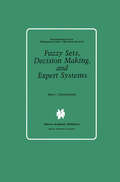- Table View
- List View
System Firmware: An Essential Guide to Open Source and Embedded Solutions
by Vincent Zimmer Subrata BanikFind the right bootloader solution or combination of firmware required to boot a platform considering its security, product features, and optimized boot solutions. This book covers system boot firmware, focusing on real-world firmware migration from closed source to open source adaptation. The book provides an architectural overview of popular boot firmware. This includes both closed sourced and/or open source in nature, such as Unified Extensible Firmware Interface (UEFI), coreboot, and Slim Bootloader and their applicable market segments based on product development and deployment requirements. Traditional system firmware is often complex and closed sourced whereas modern firmware is still a kind of hybrid between closed and open source. But what might a future firmware model look like? The most simplistic boot firmware solution uses open source firmware development. This book helps you decide how to choose the right boot firmware for your products and develop your own boot firmware using open source. Coverage includes: Why open source firmware is used over closed sourceThe pros and cons of closed and open source firmwareA hybrid work model: for faster bring-up activity using closed source, binary integrated with open source firmware What You Will LearnUnderstand the architecture of standard and popular boot firmwarePick the correct bootloader for your required target hardwareDesign a hybrid workflow model for the latest chipset platformUnderstand popular payload architectures and offerings for embedded systemsSelect the right payload for your bootloader solution to boot to the operating systemOptimize the system firmware boot time based on your target hardware requirementKnow the product development cycle using open source firmware developmentWho This Book Is For Embedded firmware and software engineers migrating the product development from closed source firmware to open source firmware for product adaptation needs as well as engineers working for open source firmware development. A secondary audience includes engineers working on various bootloaders such as open source firmware, UEFI, and Slim Bootloader development, as well as undergraduate and graduate students working on developing firmware skill sets.
Embedded Firmware Solutions: Development Best Practices for the Internet of Things
by Vincent Zimmer Jiming Sun Marc Jones Stefan ReinauerEmbedded Firmware Solutions is the perfect introduction and daily-use field guide--for the thousands of firmware designers, hardware engineers, architects, managers, and developers--to Intel’s new firmware direction (including Quark coverage), showing how to integrate Intel® Architecture designs into their plans.Featuring hands-on examples and exercises using Open Source codebases, like Coreboot and EFI Development Kit (tianocore) and Chromebook, this is the first book that combines a timely and thorough overview of firmware solutions for the rapidly evolving embedded ecosystem with in-depth coverage of requirements and optimization.
Building Secure Firmware: Armoring the Foundation of the Platform
by Vincent Zimmer Jiewen YaoUse this book to build secure firmware.As operating systems and hypervisors have become successively more hardened, malware has moved further down the stack and into firmware. Firmware represents the boundary between hardware and software, and given its persistence, mutability, and opaqueness to today’s antivirus scanning technology, it represents an interesting target for attackers.As platforms are universally network-connected and can contain multiple devices with firmware, and a global supply chain feeds into platform firmware, assurance is critical for consumers, IT enterprises, and governments. This importance is highlighted by emergent requirements such as NIST SP800-193 for firmware resilience and NIST SP800-155 for firmware measurement. This book covers the secure implementation of various aspects of firmware, including standards-based firmware—such as support of the Trusted Computing Group (TCG), Desktop Management Task Force (DMTF), and Unified Extensible Firmware Interface (UEFI) specifications—and also provides code samples and use cases. Beyond the standards, alternate firmware implementations such as ARM Trusted Firmware and other device firmware implementations (such as platform roots of trust), are covered. What You Will Learn Get an overview of proactive security development for firmware, including firmware threat modelingUnderstand the details of architecture, including protection, detection, recovery, integrity measurement, and access controlBe familiar with best practices for secure firmware development, including trusted execution environments, cryptography, and language-based defensesKnow the techniques used for security validation and maintenanceWho This Book Is ForGiven the complexity of modern platform boot requirements and the threat landscape, this book is relevant for readers spanning from IT decision makers to developers building firmware
Ansturm der Algorithmen: Die Verwechslung von Urteilskraft mit Berechenbarkeit (Die blaue Stunde der Informatik)
by Wolf ZimmerDer durch die „Blumenkinder“ des Silicon Valley entfesselte digitale Rausch droht, die Vernunft durch den Aberglauben zu ersetzen, man könne die Welt rechnend vervollkommnen. Wer aber glaubt, die Probleme einer ungewissen Welt mit technologischen Gewissheiten lösen zu können, hat weder etwas von der Welt noch etwas von der Technologie verstanden. Im digitalen Sittenbild aus Silizium und Statistik ersetzt Rechnen das Denken, Wahrscheinlichkeit wird für Wahrheit ausgegeben und Korrelation verdrängt Kausalität. Die Hohepriester der Digitalisierung fragen nicht, ob wir das, was sie verkünden, für gut und richtig halten. Gut und richtig sind keine Kategorien des Digitalen.
Schutz vor Rechtsproblemen im Internet: Handbuch für Unternehmen
by Jürgen Zimmerling Ulrich WernerDas Internet als supranationaler Raum öffentlichen Rechts ist keineswegs rechtsfrei, es stellt vielmehr das Recht vor Fragen bisher nicht gekannter Komplexität. Das Buch behandelt die wichtigsten Bereiche kommerzieller Internet-Nutzung unter dem Gesichtspunkt des deutschen Rechts und beschreibt die häufigsten rechtlichen Fallstricke. Nach einer Einführung in die Grundlagen des Cyberspace geht es schwerpunktmäßig um Domain-Namensrecht, Inhalt und Gestaltung von Webseiten, Verträge per E-Mail und HTML-Formular, Einbeziehung der Allgemeinen Geschäftsbedingungen (AGB), Werbung und Verkauf im World Wide Web sowie Datenerhebung und Marktforschung. Dabei werden insbesondere die unterschiedlichen Positionen der aktuell kontroversen Diskussion herausgearbeitet und rechtlich bewertet. Hervorzuheben ist, daß sich das Buch nicht an der juristischen Klassifikation orientiert, sondern an den praktischen Komponenten des Einsatzes von Internet-Technologien zur Marktkommunikation.
X-Ways Forensics Practitioner’s Guide
by Eric Zimmerman Brett ShaversThe X-Ways Forensics Practitioner's Guide is more than a manual-it's a complete reference guide to the full use of one of the most powerful forensic applications available, software that is used by a wide array of law enforcement agencies and private forensic examiners on a daily basis. In the X-Ways Forensics Practitioner's Guide, the authors provide you with complete coverage of this powerful tool, walking you through configuration and X-Ways fundamentals, and then moving through case flow, creating and importing hash databases, digging into OS artifacts, and conducting searches. With X-Ways Forensics Practitioner's Guide, you will be able to use X-Ways Forensics to its fullest potential without any additional training. The book takes you from installation to the most advanced features of the software. Once you are familiar with the basic components of X-Ways, the authors demonstrate never-before-documented features using real life examples and information on how to present investigation results. The book culminates with chapters on reporting, triage and preview methods, as well as electronic discovery and cool X-Ways apps.Provides detailed explanations of the complete forensic investigation processe using X-Ways Forensics.Goes beyond the basics: hands-on case demonstrations of never-before-documented features of X-Ways.Provides the best resource of hands-on information to use X-Ways Forensics.
Python Descriptors
by Jacob ZimmermanCreate descriptors and see ideas and examples of how to use descriptors effectively. In this short book, you’ll explore descriptors in general, with a deep explanation of what descriptors are, how they work, and how they're used. Once you understand the simplicity of the descriptor protocol, the author delves into using and creating descriptors in practice, with plenty of tips, patterns, and real-world guidance. Because descriptors are inherently flexible, you’ll work with multiple examples illustrating how to best take advantage of them.This second edition includes additions throughout, including new material covering the set_name_() descriptors, new and improved flowcharts to explain the inner workings of descriptors, and a completely new chapter to address instance-level attributes, the easiest way to create descriptors correctly the first time. Although brief, Python Descriptors is a comprehensive guide to creating Python descriptors, including a pip install-able library called descriptor_tools, which was written alongside this book and is an open source library on GitHub. After reading this book, you will have a solid understanding of how descriptors work and the techniques to avoid the big gotchas associated with working with them.What You Will LearnDiscover descriptor protocolsMaster attribute access and how it applies to descriptorsBuild your own descriptorsUse descriptors to store attributesCreate read-only descriptors Explore the descriptor classesApply the other uses of descriptors Who This Book Is ForExperienced Python coders, programmers, and developers.
Python Descriptors: Understanding And Using The Descriptor Protocol
by Jacob ZimmermanThis short book on Python descriptors is a collection of knowledge and ideas from many sources on dealing with and creating descriptors. And, after going through the things all descriptors have in common, the author explores ideas that have multiple ways of being implemented as well as completely new ideas never seen elsewhere before.This truly is a comprehensive guide to creating Python descriptors. As a bonus: A pip install-able library, descriptor_tools, was written alongside this book and is an open source library on GitHub.There aren't many good resources out there for writing Python descriptors, and extremely few books. This is a sad state of affairs, as it makes it difficult for Python developers to get a really good understanding of how descriptors work and the techniques to avoid the big gotchas associated with working with them.What You Will LearnDiscover descriptor protocolsMaster attribute access and how it applies to descriptorsMake descriptors and discover why you shouldStore attributesCreate read-only descriptors and _delete()Explore the descriptor classesApply the other uses of descriptors and moreWho This Book Is ForExperienced Python coders, programmers and developers.
Social Media Marketing All-in-One For Dummies
by Jan Zimmerman Deborah NgThe bestselling social media marketing book Marketing your business through social media isn't an option these days—it's absolutely imperative. In this new edition of the bestselling Social Media Marketing All-in-One For Dummies, you'll get comprehensive, expert guidance on how to use the latest social media platforms to promote your business, reach customers, and thrive in the global marketplace. Social media continues to evolve at breakneck speed, and with the help of this guide, you'll discover how to devise and maintain a successful social media strategy, use the latest tactics for reaching your customers, and utilize data to make adjustments to future campaigns and activities. Plus, you'll find out how to apply the marketing savvy you already have to the social media your prospects are using, helping you to reach—and keep—more customers, make more sales, and boost your bottom line. Includes the latest changes to Facebook, Twitter, Pinterest, LinkedIn, YouTube, and more Offers tips for engaging your community and measuring your efforts Explains how to blend social media with your other online and offline marketing efforts Shows you how to leverage data to learn more about your community Don't get left behind! Let this book help you get the most from every minute and dollar you spend on marketing.
Social Media Marketing All-in-One For Dummies
by Jan Zimmerman Deborah NgThe bestselling social media marketing book Marketing your business through social media isn't an option these days—it's absolutely imperative. In this new edition of the bestselling Social Media Marketing All-in-One For Dummies, you'll get comprehensive, expert guidance on how to use the latest social media platforms to promote your business, reach customers, and thrive in the global marketplace. Social media continues to evolve at breakneck speed, and with the help of this guide, you'll discover how to devise and maintain a successful social media strategy, use the latest tactics for reaching your customers, and utilize data to make adjustments to future campaigns and activities. Plus, you'll find out how to apply the marketing savvy you already have to the social media your prospects are using, helping you to reach—and keep—more customers, make more sales, and boost your bottom line. Includes the latest changes to Facebook, Twitter, Pinterest, LinkedIn, YouTube, and more Offers tips for engaging your community and measuring your efforts Explains how to blend social media with your other online and offline marketing efforts Shows you how to leverage data to learn more about your community Don't get left behind! Let this book help you get the most from every minute and dollar you spend on marketing.
Complete Guide to OneNote
by Scott Zimmerman* OneNote has the potential to be the next "killer-app" in the Microsoft Office family * Author already has public visibility in the OneNote field as author of a related web site (OneNoteInfoCenter.com) and first OneNote MVP * Advanced content will differentiate the book from numerous beginner’s texts * Early to market will allow this book to establish it as the definitive book on the subject. * OneNote will be part of the Microsoft Office family and Office titles sell well
Human Centred Intelligent Systems: Proceedings of KES-HCIS 2023 Conference (Smart Innovation, Systems and Technologies #359)
by Alfred Zimmermann R. J. Howlett Lakhmi C. JainThe volume includes papers presented at the International KES Conference on Human Centred Intelligent Systems 2023 (KES HCIS 2023), held in Rome, Italy on June 14–16, 2023. This book highlights new trends and challenges in intelligent systems, which play an important part in the digital transformation of many areas of science and practice. It includes papers offering a deeper understanding of the human-centred perspective on artificial intelligence, of intelligent value co-creation, ethics, value-oriented digital models, transparency, and intelligent digital architectures and engineering to support digital services and intelligent systems, the transformation of structures in digital businesses and intelligent systems based on human practices, as well as the study of interaction and the co-adaptation of humans and systems.
Human Centred Intelligent Systems: Proceedings of KES-HCIS 2022 Conference (Smart Innovation, Systems and Technologies #310)
by Alfred Zimmermann Robert J. Howlett Lakhmi C. JainThe volume includes papers presented at the International KES Conference on Human Centred Intelligent Systems 2022 (KES HCIS 2022), held in Rhodes, Greece on June 20–22, 2022. This book highlights new trends and challenges in intelligent systems, which play an important part in the digital transformation of many areas of science and practice. It includes papers offering a deeper understanding of the human-centred perspective on artificial intelligence, of intelligent value co-creation, ethics, value-oriented digital models, transparency, and intelligent digital architectures and engineering to support digital services and intelligent systems, the transformation of structures in digital businesses and intelligent systems based on human practices, as well as the study of interaction and the co-adaptation of humans and systems.
Human Centred Intelligent Systems: Proceedings of KES-HCIS 2020 Conference (Smart Innovation, Systems and Technologies #189)
by Alfred Zimmermann Robert J. Howlett Lakhmi C. JainThis book highlights new trends and challenges in intelligent systems, which play an important part in the digital transformation of many areas of science and practice. It includes papers offering a deeper understanding of the human-centred perspective on artificial intelligence, of intelligent value co-creation, ethics, value-oriented digital models, transparency, and intelligent digital architectures and engineering to support digital services and intelligent systems, the transformation of structures in digital businesses and intelligent systems based on human practices, as well as the study of interaction and the co-adaptation of humans and systems. All papers were originally presented at the International KES Conference on Human Centred Intelligent Systems 2020 (KES HCIS 2020), held on June 17–19, 2020, in Split, Croatia.
Human Centred Intelligent Systems: Proceedings of KES-HCIS 2021 Conference (Smart Innovation, Systems and Technologies #244)
by Alfred Zimmermann Robert J. Howlett Lakhmi C. Jain Rainer SchmidtThis book highlights new trends and challenges in intelligent systems, which play an essential part in the digital transformation of many areas of science and practice. It includes papers offering a deeper understanding of the human-centred perspective on artificial intelligence, of intelligent value co-creation, ethics, value-oriented digital models, transparency, and intelligent digital architectures and engineering to support digital services and intelligent systems, the transformation of structures in digital business and intelligent systems based on human practices, as well as the study of interaction and co-adaptation of humans and systems. All papers were originally presented at the International KES Conference on Human Centred Intelligent Systems 2021 (KES HCIS 2021) held on June 14–16, 2021 in the KES Virtual Conference Centre.
Architecting the Digital Transformation: Digital Business, Technology, Decision Support, Management (Intelligent Systems Reference Library #188)
by Alfred Zimmermann Rainer Schmidt Lakhmi C. JainThis research-oriented book presents key contributions on architecting the digital transformation. It includes the following main sections covering 20 chapters: · Digital Transformation · Digital Business · Digital Architecture · Decision Support · Digital Applications Focusing on digital architectures for smart digital products and services, it is a valuable resource for researchers, doctoral students, postgraduates, graduates, undergraduates, academics and practitioners interested in digital transformation.
Architektur der digitalen Transformation: Digital Business, Technologie, Entscheidungsunterstützung, Management
by Alfred Zimmermann Rainer Schmidt Lakhmi C. JainDieses forschungsorientierte Buch enthält wichtige Beiträge zur Gestaltung der digitalen Transformation. Es umfasst die folgenden Hauptabschnitte in 20 Kapiteln:- Digitale Transformation- Digitales Geschäft- Digitale Architektur- Entscheidungshilfe- Digitale Anwendungen Es konzentriert sich auf digitale Architekturen für intelligente digitale Produkte und Dienstleistungen und ist eine wertvolle Ressource für Forscher, Doktoranden, Postgraduierte, Absolventen, Studenten, Akademiker und Praktiker, die sich für die digitale Transformation interessieren.
Stochastic Discrete Event Systems: Modeling, Evaluation, Applications
by Armin ZimmermannStochastic discrete-event systems (SDES) capture the randomness in choices due to activity delays and the probabilities of decisions. This book delivers a comprehensive overview on modeling with a quantitative evaluation of SDES. It presents an abstract model class for SDES as a pivotal unifying result and details important model classes. The book also includes nontrivial examples to explain real-world applications of SDES.
GI-NTG Fachtagung Struktur und Betrieb von Rechensystemen: Kiel, 19.–21. März 1980 (Informatik-Fachberichte #27)
by G. ZimmermannFuzzy Set Theory — and Its Applications (International Series in Management Science Operations Research)
by Hans-Jürgen ZimmermannFuzzy Set Theory — and Its Applications
by Hans-Jürgen ZimmermannSince its inception 20 years ago the theory of fuzzy sets has advanced in a variety of ways and in many disciplines. Applications of this theory can be found in artificial intelligence, computer science, control engineering, decision theory, expert systems, logic, management science, operations research, pattern recognition, robotics and others. Theoretical advances, too, have been made in many directions, and a gap has arisen between advanced theoretical topics and applications, which often use the theory at a rather elementary level. The primary goal of this book is to close this gap - to provide a textbook for courses in fuzzy set theory and a book that can be used as an introduction. This revised book updates the research agenda, with the chapters of possibility theory, fuzzy logic and approximate reasoning, expert systems and control, decision making and fuzzy set models in operations research being restructured and rewritten. Exercises have been added to almost all chapters and a teacher's manual is available upon request.
Fuzzy Set Theory—and Its Applications
by Hans-Jürgen ZimmermannFuzzy Set Theory - And Its Applications, Third Edition is a textbook for courses in fuzzy set theory. It can also be used as an introduction to the subject. The character of a textbook is balanced with the dynamic nature of the research in the field by including many useful references to develop a deeper understanding among interested readers. The book updates the research agenda (which has witnessed profound and startling advances since its inception some 30 years ago) with chapters on possibility theory, fuzzy logic and approximate reasoning, expert systems, fuzzy control, fuzzy data analysis, decision making and fuzzy set models in operations research. All chapters have been updated. Exercises are included.
Fuzzy Set Theory—and Its Applications
by Hans-Jürgen ZimmermannThis introduction to fuzzy set theory and its multitude of applications seeks to balance the character of the book with the dynamic nature of the research. This edition includes new chapters on possibility theory, fuzzy logic and approximate reasoning, expert systems, fuzzy control, fuzzy data analysis, decision making and fuzzy set models in operations research. Existing material has been updated, and extended exercises are included.
Fuzzy Sets, Decision Making, and Expert Systems (International Series in Management Science Operations Research #10)
by Hans-Jürgen ZimmermannIn the two decades since its inception by L. Zadeh, the theory of fuzzy sets has matured into a wide-ranging collection of concepts, models, and tech niques for dealing with complex phenomena which do not lend themselves to analysis by classical methods based on probability theory and bivalent logic. Nevertheless, a question which is frequently raised by the skeptics is: Are there, in fact, any significant problem areas in which the use of the theory of fuzzy sets leads to results which could not be obtained by classical methods? The approximately 5000 publications in this area, which are scattered over many areas such as artificial intelligence, computer science, control engineering, decision making, logic, operations research, pattern recognition, robotics and others, provide an affirmative answer to this question. In spite of the large number of publications, good and comprehensive textbooks which could facilitate the access of newcomers to this area and support teaching were missing until recently. To help to close this gap and to provide a textbook for courses in fuzzy set theory which can also be used as an introduction to this field, the first volume ofthis book was published in 1985 [Zimmermann 1985 b]. This volume tried to cover fuzzy set theory and its applications as extensively as possible. Applications could, therefore, only be described to a limited extent and not very detailed.
